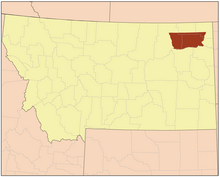Fort Peck Indian Reservation
The Fort Peck Indian Reservation is an Indian reservation of the Assiniboine ( Nakoda ) and Sioux ( Dakota and Lakota ) near Wolf Point in the northeast of the US state of Montana . It is the second largest reservation in Montana. The administrative headquarters of Assiniboine & Sioux Tribes is Poplar .
geography
The reserve has an area of 2,093,318 acres (approx. 8471 km² ).
It is 40 miles west of the state of North Dakota and 50 miles south of the Canadian border. To the south, the Missouri River borders the reserve area.
history
After the Civil War (1861–1865), groups migrating west from Dakota and Lakota allied with Assiniboine (Nakoda) and moved to the area near the Milk River (Missouri River) . In 1888, the US Congress established what is now the reservation boundary.
With the Fort Peck Allotment Act of 1908, the reserve land was parceled out and privatized. Forest, cultivation and pasture areas were allocated to the Indians, and further parcels were reserved for public facilities and railway lines. The rest of the land was released for non-Indian settlers. Less than half of the reserve area is in Indian ownership.
population
Depending on the source, there are around 10,700 to 13,382 registered Assiniboine and Sioux tribe members ( enrolled members ). Of these, around 3900 tribe members live outside the reserve. Assiniboins make up just over a third.
All of the cities on the Fort Peck reservation are along the Missouri. With a population of 4,000, Wolf Point is the largest city in the reserve and also its commercial center. The second largest city is Poplar, the seat of the Indian administration. Other cities include Frazer , Oswego , Brockton , Riverside and Fort Kipp .
economy
Poplar is home to one of the largest industrial parks in Montana, including metal and textile production. Other trades such as electronics manufacturers are also represented in the reserve. Agriculture, livestock and oil production also play an economic role in the Fort Peck reserve.
The workplaces of the Fort Peck reservation are located in animal husbandry, raw material extraction ( mining ) and agriculture. According to various sources, every second to third Indian on the reservation is unemployed. The poverty rate is around 25%, well above the American average.
Water rights
Negotiations to clarify water rights have been taking place in Montana since the 1970s . As the first Indian tribe in Montana, the Assiniboine and Sioux signed a Water Rights Compact (often simply called “Compact”) for the Fort Peck Reservation in 1985 . Accordingly, the reserve is allowed to divert 1 million acre feet (approx. 1.2 billion m 3 ) of water from the Missouri and its tributaries.
education
Founded in 1979, Fort Peck Community College offers one-year courses and an associate degree in Arts and Sciences .
politics
According to the Tribal Constitution ( Constitution & By-laws of the Fort Peck Assiniboine & Sioux Tribes of the Fort Peck Reservation ), the reservation is governed by the Fort Peck Tribal Executive Board of the tribe. It consists of a chairman, a vice chairman, a secretary / accountant, a sergeant-at-arms and twelve assessors. With the exception of the Secretary-Accountant , all members are elected for a two-year term.
Members of the 2015-2017 electoral term are:
- Chair: Floyd Azure
- Vice-Chair: Charlie Headdress
- Secretary / Accountant: Jackie Weeks (Appointed)
- Sergeant-at-Arms: Jestin Dupree
- Assessor:
- Edward Bauer
- Dana Buckles
- Marva Chapman
- Tommy Christian
- Leonard Crowbelt
- Roxanne Gourneau
- Lonnie headdress
- Pearl Hopkins
- Melvin Rattling Thunder Sr.
- Tony Shields Sr.
- Grant Stafne
- Stacey Summers
Web links
Individual evidence
- ↑ Fort Peck Indian Reservation ( English ) In: Geographic Names Information System . United States Geological Survey . Retrieved May 7, 2016.
- ↑ a b c d e f g h Montana Governor's Office of Indian Affairs: Nakoda Dakota - Assiniboine & Sioux Tribes
- ↑ a b c d e f g h Office of Public Instruction: Montana Indians: Their History and Location ( Memento of the original from April 29, 2014 in the Internet Archive ) Info: The archive link was inserted automatically and has not yet been checked. Please check the original and archive link according to the instructions and then remove this notice. (PDF), version dated March 2, 2016. pp. 56–61
- ^ A b Bureau of Indian Affairs : Fort Peck Agency
- ^ A b c American Indian Relief Council (AIRC): Montana: Fort Peck Reservation
- ↑ a b Montana Tribes: Fort Peck Reservation ( Memento of the original from January 10, 2011 in the Internet Archive ) Info: The archive link was inserted automatically and has not yet been checked. Please check the original and archive link according to the instructions and then remove this notice.
